Power supplies from phone chargers to EVs to industrial machinery rely on semiconductors, either in discrete packages or integrated into power modules, to deliver power. APEC 2024 was full of power sources and components. The roundup below highlights regulators, switches, and power semiconductors. We also highlight wireless power delivery and chargers.
Be sure to see EE World’s APEC 2024 coverage on datacenter power and test equipment.
Alpha & Omega Semiconductor
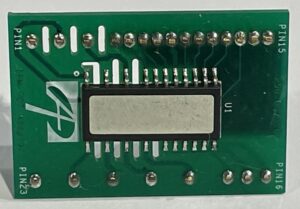 Electronics generate heat. It’s what they do. Alpha & Omega Semiconductor has developed a package that it calls MEGA IPM7 for its intelligent power modules. The SMD package contains an embedded IGBT for motor drives in appliances such as refrigerators, washing machines, and air conditioners. What makes the package different is its surface contains metal, which helps to pull heat away from the embedded device.
Electronics generate heat. It’s what they do. Alpha & Omega Semiconductor has developed a package that it calls MEGA IPM7 for its intelligent power modules. The SMD package contains an embedded IGBT for motor drives in appliances such as refrigerators, washing machines, and air conditioners. What makes the package different is its surface contains metal, which helps to pull heat away from the embedded device.
Analog Devices
 Analog Devices introduced the LT8418, a 100 V half-bridge GaN gate driver. Designed to minimize EMI issues, the LT8418’s split gate drivers let you adjust a GaN FET’s turn-on and turn-off slew rates. The device can source up to 4 A peak and sink up to 8 A.
Analog Devices introduced the LT8418, a 100 V half-bridge GaN gate driver. Designed to minimize EMI issues, the LT8418’s split gate drivers let you adjust a GaN FET’s turn-on and turn-off slew rates. The device can source up to 4 A peak and sink up to 8 A.

Bourns
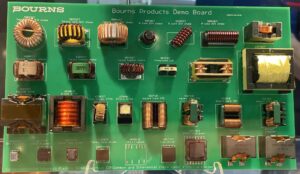 The manufacturer of power magnetics, circuit-protection devices, sensors, switches, and other devices focused on transformers chokes, gate drivers, and toroids.
The manufacturer of power magnetics, circuit-protection devices, sensors, switches, and other devices focused on transformers chokes, gate drivers, and toroids.
Brightworks
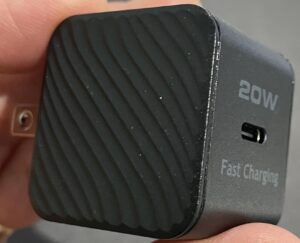 Many of the power semiconductors seen at APEC have been designed into phone and laptop chargers from well-known manufacturers such as Anker, Belkin, and others, some of which will remain nameless. Brightworks manufactures chargers and power supplies that other companies private brand, using some of those power semiconductors. The photo shows a 20 W USB-C charger that the company let me take home. I’m tempted to crack open the case to see what’s inside.
Many of the power semiconductors seen at APEC have been designed into phone and laptop chargers from well-known manufacturers such as Anker, Belkin, and others, some of which will remain nameless. Brightworks manufactures chargers and power supplies that other companies private brand, using some of those power semiconductors. The photo shows a 20 W USB-C charger that the company let me take home. I’m tempted to crack open the case to see what’s inside.
Empower Semiconductor
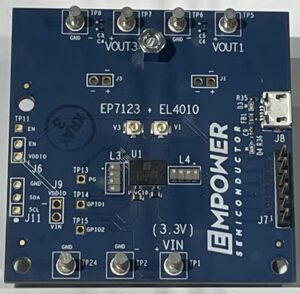 The manufacturer of voltage regulators, silicon capacitors, and interposers exhibited an evaluation board for its EP7123 dual-output integrated voltage regulator. Each output supplies up to 6 A with a 3.3 V input. Other parts in the series include one, three, and four outputs.
The manufacturer of voltage regulators, silicon capacitors, and interposers exhibited an evaluation board for its EP7123 dual-output integrated voltage regulator. Each output supplies up to 6 A with a 3.3 V input. Other parts in the series include one, three, and four outputs.
Infineon
At APEC 2024, Infineon introduced the TDM22544D and TDM22545D high-density power modules designed for data center processors. The modules package a MOSFET with an inductor that’s surrounded by heat-dissipating metal.
Operating from the Infineon booth, AWL Electricity showed a rather unusual demonstration of wireless power transfer. In this video, Cédric Hamel-Bruneau uses a modified lamp with an LED bulb at one end and no power cord on the other. Instead, the base holds a receiver that receives power from a transmitter. The concept uses electric-fields to transfer power through capacitive coupling. That’s different than, say, a wireless charger that uses magnetic fields and inductive coupling.
Menlo Micro
You might think of Menlo Micro’s switching products for communications, 5G, and test & measurement but the company also makes power switches. The video shows a demonstration of the MM9200 power switch. Here, Menlo Micro shows a set of these switches running in a serial-parallel combination that the company says runs cooler than an identical configuration using SiC.
Microchip
Microchip exhibited the MAICMMC40X120 Aviation Power Core module that integrates an SiC MOSFET with drivers and a microcontroller. It can produce AC power with variable frequencies to drive motors for aerospace and defense applications.
Qorvo
 The company introduced a series of SiC 1200 V half-bridge and full bridge power modules. The four modules in the UHBxxx12E1BC3N series have drain currents of 17 A, 25 A, 50 A, and 100 A with RDS(ON) at 70 mΩ, 35 mΩ, 19 mΩ, and 9.4 mΩ, respectively.
The company introduced a series of SiC 1200 V half-bridge and full bridge power modules. The four modules in the UHBxxx12E1BC3N series have drain currents of 17 A, 25 A, 50 A, and 100 A with RDS(ON) at 70 mΩ, 35 mΩ, 19 mΩ, and 9.4 mΩ, respectively.
Power Integrations
In the video, Andrew Smith explains how the company achieves multiple DC rails with a single chip. The InnoMux 2-EP is a zero-voltage switching (ZVS) flyback switcher that selects which of its loads needs energy.
TDK
TDK’s µPOL (point-of-load) DC-DC converters provide telemetry for parameters such as voltage, current, and temperature. The demonstration in the video shows a 12 A regulator sending telemetry to a computer. The converter’s output range is 0.6 V to 1.8 V.

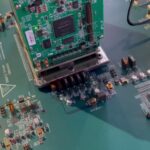




Leave a Reply